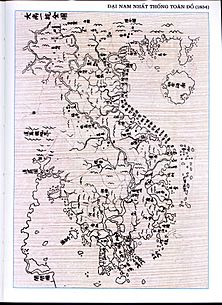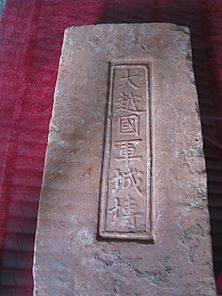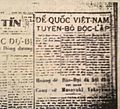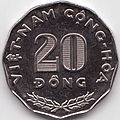Names of Vietnam facts for kids
Throughout history, there were many names used to refer to Vietnam.
History
Throughout history of Vietnam, besides official names, there are names that are used unofficially to refer to the territory of Vietnam. Vietnam was ever called Văn Lang during the Hùng Vương Dynasty, Âu Lạc when An Dương was king, Nam Việt during the Triệu Dynasty, Van Xuan during the Anterior Lý Dynasty, Đại Cồ Việt during the Đinh dynasty and Early Lê dynasty. Starting in 1054, Vietnam was called Đại Việt (Great Viet). During the Hồ dynasty, Vietnam was called Đại Ngu.
Việt Nam ( in Vietnamese) is a variation of Nam Việt (Southern Việt), a name that can be traced back to the Triệu dynasty (2nd century BC, also known as Nanyue Kingdom). The word "Việt" originated as a shortened form of Bách Việt, a word used to refer to a people who lived in what is now southern China in ancient times. The word "Việt Nam", with the syllables in the modern order, first appears in the 16th century in a poem by Nguyễn Bỉnh Khiêm. "Annam", which originated as a Chinese name in the seventh century, was the common name of the country during the colonial period. Nationalist writer Phan Bội Châu revived the name "Vietnam" in the early 20th century. When rival communist and anti-communist governments were set up in 1945, both immediately adopted this as the country's official name. In English, the two syllables are usually combined into one word, "Vietnam". However, "Viet Nam" was once common usage and is still used by the United Nations and by the Vietnamese government.
Origin of Vietnam
The term "Việt" (Yue) (Chinese: 越; pinyin: Yuè; Cantonese Yale: Yuht; Wade–Giles: Yüeh4; Vietnamese: Việt), Early Middle Chinese was first written using the logograph "戉" for an axe (a homophone), in oracle bone and bronze inscriptions of the late Shang dynasty (c. 1200 BC), and later as "越". At that time it referred to a people or chieftain to the northwest of the Shang. In the early 8th century BC, a tribe on the middle Yangtze were called the Yangyue, a term later used for peoples further south. Between the 7th and 4th centuries BC Yue/Việt referred to the State of Yue in the lower Yangtze basin and its people.
From the 3rd century BC the term was used for the non-Chinese populations of south and southwest China and northern Vietnam, with particular states or groups called Minyue, Ouyue, Luoyue (Vietnamese: Lạc Việt), etc., collectively called the Baiyue (Bách Việt, Chinese: 百越; pinyin: Bǎiyuè; Cantonese Yale: Baak Yuet; Vietnamese: Bách Việt; "Hundred Yue/Viet"; ). The term Baiyue/Bách Việt first appeared in the book Lüshi Chunqiu compiled around 239 BC.
In 207 BC, former Qin dynasty general Zhao Tuo/Triệu Đà founded the kingdom Nanyue/Nam Việt (Chinese: 南越; "Southern Yue/Việt") with its capital at Panyu (modern Guangzhou). This kingdom was "southern" in the sense that it was located south of other Baiyue kingdoms such as Minyue and Ouyue, located in modern Fujian and Zhejiang. Several later Vietnamese dynasties followed this nomenclature even after these more northern peoples were absorbed into China.
In "Sấm Trạng Trình" (The Prophecies of Trạng Trình), poet Nguyen Binh Khiêm (1491–1585) reversed the traditional order of the syllables and put the name in its modern form: "Vietnam is being created" (Việt Nam khởi tổ xây nền). At this time, the country was divided between the Trịnh lords of Hanoi and the Nguyễn lords of Huế. By combining several existing names, Nam Việt, Annam (Pacified South), Đại Việt (Great Việt), and "Nam quốc" (southern nation), Khiêm could create a new name that referred to an aspirational unified state. The word "nam" no longer implies Southern Việt, but rather that Vietnam is "the South" in contrast to China, "the North". This explanation is implied by Lý Thường Kiệt in the poem "Nam quốc sơn hà" (1077): "Over the mountains and rivers of the South, reigns the emperor of the South." Researcher Nguyễn Phúc Giác Hải found the word 越南 "Việt Nam" on 12 steles carved in the 16th and 17th centuries, including one at Bảo Lâm Pagoda, Haiphong (1558). Nguyễn Phúc Chu (1675–1725) used the word in a poem: "This is the most dangerous mountain in Vietnam" (Việt Nam hiểm ải thử sơn điên). It was used as an official name by Emperor Gia Long in 1804-1813. The Jiaqing Emperor refused Gia Long's request to change his country's name to Nam Việt, and changed the name instead to Việt Nam. Gia Long's Đại Nam thực lục contains the diplomatic correspondence over the naming.
The use of "Vietnam" was revived in modern times by nationalists including Phan Bội Châu, whose book Việt Nam vong quốc sử (History of the Loss of Vietnam) was published in 1906. Chau also founded the Việt Nam Quang Phục Hội (Vietnam Restoration League) in 1912. However, the general public continued to use Annam and the name "Vietnam" remained virtually unknown until the Yên Bái mutiny of 1930, organized by the Việt Nam Quốc Dân Đảng (Vietnamese Nationalist Party). By the early 1940s, the use of "Việt Nam" was widespread. It appeared in the name of Ho Chi Minh's Viet Nam Doc Lap Dong Minh Hoi (Viet Minh), founded 1941, and was even used by the governor of French Indochina in 1942. The name "Vietnam" has been official since 1945. It was adopted in June by Bảo Đại's imperial government in Huế, and in September by Ho's rival communist government in Hanoi.
Other names
- 遂交南方,為子孫基址 / Toại giao Nam phương, vị tử tôn trụ chỉ (Ứng Thiệu, Hán quan nghi ; Thái Bình ngự lãm chap. 157).
- 南方曰蠻,雕題交阯 / Nam phương viết man, điêu đề giao chỉ (Lễ kí).
- 其俗男女同川而浴,故曰交阯 / Kì tục nam nữ đồng xuyên nhi dục, cố viết giao chỉ (Hậu Hán thư, Nam man Tây Nam di ngoại truyện).
- 交趾之地頗爲膏腴,徙民居之,始知播植,厥土惟黑壤,厥氣惟雄,故今稱其田為雄田,其民為雄民,有君長亦曰雄王,有輔佐焉亦曰雄侯,分其地以為雄將。(出南越志) (Thái Bình quảng kí).
- 交趾昔未有郡縣之時,土地有雒田,其田從潮水上下,民墾食其田,因名為雒民,設雒王、雒侯,主諸郡縣。縣多為雒將,雒將銅印青綬 (Thủy kinh chú, Giao châu ngoại vực kí).
-
- 1. Legendary
| Time | Name | Polity |
|---|---|---|
| 2879 - 2524 BC | Xích Quỷ, Thích Quỷ Txiv 赤鬼 |
Hồng Bàng clan - Kurung |
| 2524 - 258 BC | Văn Lang, Mê Linh Maling, Minang 文郎, 麊泠 |
Hồng Bàng clan - Kurung |
| 257 - 207 BC | Âu Lạc Urang?, Orang?, Anak 甌雒, 甌駱 |
Hồng Bàng clan - An Dương Vương |
| 40 - 43 | Lĩnh Nam Maling?, Minang? Niálâm, Niannang 嶺南, 麊泠 |
Hồng Bàng clan - Turun |
-
- 2a. Official pre-1945

| Time | Name | Polity |
|---|---|---|
| 204 BC - 111 BC | Nam Việt [quốc] 南越 |
Triệu dynasty |
| 111 BC - 938 1407 - 1427 |
Giao Chỉ [xứ] 交址, 交阯, 交趾 |
Chinese domination |
| 203 - 544 602 - 607 |
Giao châu 交州 |
Chinese domination |
| 544 - 602 | Vạn Xuân [quốc] 萬春 |
Anterior Lý dynasty |
| 679 - 757 766 - 866 |
Annam [phủ] 安南 |
Chinese domination |
| 757 - 766 | Trấn Nam [phủ] 鎮南 |
Chinese domination |
| 866 - 965 | Tĩnh Hải [quân] 靜海 |
Chinese domination |
| 968 - 1054 | Đại Cồ-việt [quốc] 大瞿越 |
Đinh dynasty Early Lê dynasty Lý dynasty |
| 1054 - 1400 1428 - 1804 |
Đại Việt [quốc] 大越 |
Lý dynasty Trần dynasty Hồ dynasty Lê dynasty Mạc dynasty Tây Sơn dynasty Nguyễn dynasty |
| 1400 - 1407 | Đại Ngu [quốc] 大虞 |
Hồ dynasty |
| 1804 - 1839 | Việt Nam [quốc] 越南 |
Nguyễn dynasty |
| 1839 - 1945 | Đại Nam [quốc] 大南 |
Nguyễn dynasty |
-
- 2b. Official since 1945
- Đế quốc Việt Nam (越南帝國, Empire of Vietnam) : 11 March - 25 August 1945.
- Việt Nam Dân chủ Cộng hòa (越南民主共和國, Democratic Republic of Vietnam) : 02 September 1945 - 18 February 1947, 10 October 1954 - 02 July 1976.
- Quốc gia Việt Nam (越南國, State of Vietnam) : 27 May 1948 - 26 October 1955.
- Việt Nam Cộng hòa (越南共和國, Republic of Vietnam) : 26 October 1955 - 30 April 1975.
- Cộng hòa Xã hội chủ nghĩa Việt Nam (越南社會主義共和國, Socialist Republic of Vietnam) : 02 July 1976 to now.
-
- 3. Non-official
- Việt Thường thị (越常, 越嘗, 越裳氏) : The name of people who lived at the South of Nanling Mountains.
- Nam Cương vực (南疆域) or Lĩnh Ngoại vực (嶺外域) : By the Sui-Tang dynasties which to difference the Lǐngnán.
- Hoàng Việt quốc (皇越國) : The diplomatic name and on the old books. It means "Country Viet in the South" (越國之南).
- An Nam quốc (安南國) or Giao Chỉ quốc (交趾國) : The calling by Viet people and foreigns.
- Nam Việt quốc (南越國) : Nguyễn dynasty had proposed but Qing dynasty rebuffed.
- Đại Huế quốc (大化國) : Request for changing national name in 1839 but emperor Nguyễn Thánh Tổ has refused. Huế/Hóa means Thanh Hóa, Thuận Hóa/Huế, giáo hóa (nurturing).
- Đại Nam đế quốc (大南帝國) or Empire d'Annam (1858? - 1945) : The diplomatic name and on the piastre.
- Union indochinoise (1887 - 1945), Fédération indochinoise (1947 - 1953) or Liên bang Đông Dương.
- Đại Hùng đế quốc (大雄帝國, 30 August 1917 - 11 January 1918) : Only Thái Nguyên uprising.
- Việt Nam dân quốc (越南民國, 1929? - 1930) : Only Yên Bái mutiny.
-
Telegram Dailynews has reported the "Empire of Vietnam declared independence", 11 March 1945.
-
Stamps of the Empire of Vietnam.
-
Preparing of the National Assembly elections, Phất Lộc lane, Hanoi 1946.
-
Coin of the Republic of Vietnam in 1960.
-
Stamps of the Republic of Vietnam in 1961.
-
Vietnamese Embassy in Prague on 25 April 2012.
Culture
In English, the spellings Vietnam, Viet-Nam, and Viet Nam have all been used. The 1954 edition of Webster's New Collegiate Dictionary gave both the unspaced and hyphenated forms; in response to a letter from a reader, the editors indicated that the spaced form Viet Nam was also acceptable, though they stated that because Anglophones did not know the meaning of the two words making up the name Vietnam, "it is not surprising" that there was a tendency to drop the space. In 1966, the U.S. government was known to use all three renderings, with the State Department preferring the hyphenated version. By 1981, the hyphenated form was regarded as "dated", according to Scottish writer Gilbert Adair, and he titled his book about depictions of the country in film using the unhyphenated and unspaced form "Vietnam".
The modern Chinese name for Vietnam (Chinese: 越南; pinyin: Yuènán) can be translated as "Beyond the South", leading to the folk etymology that the name is a reference to the country's location beyond the southernmost borders of China. Another theory explains that the nation was termed as such in order to emphasize the division of those who stayed in China in contrast to the people living in Vietnam.
Both Japanese and Korean formerly referred to Vietnam by their respective Sino-Xenic pronunciations of the Chinese characters for its names, but later switched to using direct phonetic transcriptions. In Japanese, following the independence of Vietnam the names Annan (安南) and Etsunan (越南) were largely replaced by the phonetic transcription Betonamu (ベトナム), written in katakana script; however, the old form is still seen in compound words (e.g. 訪越, "a visit to Vietnam"). Japan's Ministry of Foreign Affairs sometimes used an alternative spelling Vietonamu (ヴィエトナム). Similarly, in the Korean language, in line with the trend towards decreasing usage of hanja, the Sino-Korean-derived name Wollam (월남, the Korean reading of 越南) has been replaced by Beteunam (베트남) in South Korea and Wennam (윁남) in North Korea.
Images for kids











